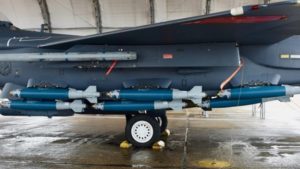
The 85th Test and Evaluation Squadron successfully flew an F-15E Strike Eagle carrying six JDAMs on a single side of the aircraft on Feb 22, 2021, showcasing a proof of concept for Agile Combat Employment, known as “ACE.”. (U.S. Air Force photo by 1st Lt
The USAF wants to use its F-15E Strike Eagle as a “bomb truck,” loading it up with 15 JDAMS for transport. A test conducted in Feb 2021 showed an F-15E loaded with 6 GBU-38 JDAMs on a single side of the aircraft. The test is proof of concept for the USAF’s Agile Combat Employment (ACE). The F-15E’s would carry weapons to remote airfields reducing the need for vulnerable C-130s which the USAF currently uses. Stefano D’urso of The Aviationist writes (abridged):
The U.S. Air Force published an interesting photo of a recent test performed by the 85th Test and Evaluation Squadron, showing an F-15E Strike Eagle (on loan from the 40th Flight Test Squadron, the same which will receive the first F-15EX) about to fly with six inert GBU-38 JDAMs on a single side of the aircraft on Feb 22, 2021. The shape of a bigger GBU-31 can be seen on the other side of the aircraft.
This test is a proof of concept for Agile Combat Employment (ACE) which aims to increase the carrying capacity of the Strike Eagle so it can act as a “bomb truck” and move fully assembled bombs that can be used at remote location to rearm the F-15E itself or other aircraft.
“Currently the F-15E is authorized to carry a max of nine JDAMs, but the success of this test expands that to 15 JDAMs,” said Maj. Andrew Swanson, F-15E Weapons System Officer, 85th TES. Until now, the F-15E was cleared to carry only three JDAMS under the three lower hardpoints of each “Fast Pack”, plus one under the centerline and other two replacing the external fuel tanks. After these tests, the Strike Eagle will be authorized to carry JDAMs also on the upper three hardpoints of the “Fast Packs”.
“The Strike Eagle can now carry enough JDAMs for an active combat mission, land at a remote location, and reload itself and/or another aircraft – such as an F-35 or F-22 – for additional combat sorties,” said Lt. Col. Jacob Lindaman, commander, 85th TES. The USAF press release noted that not all the JDAMs carried can be employed in a single mission, so it is possible that the six bombs mounted on the upper hardpoints of the “Fast Packs” may not be cleared for release in combat, restricting the F-15E to release them only from the lower hardpoints.
According to the U.S. Air Force, the ACE concept envisions the ability to generate airpower from austere airfields with varying levels of capacity and support in a contested environment, dispersing forces across different or remote airports and support their operations with fewer specialists. The purpose is “to become more agile in our execution, more strategic in our deterrence, and more resilient in our capability. Agility, Deterrence, and Resiliency are essential to defense and operational capability in a contested environment,” the U.S. Air Force in Europe website says when explaining the ACE Concept of Operations.
The USAF noted that reloading an aircraft at a remote location previously took two C-130s to carry the necessary munitions and personnel and required the bombs to be assembled after their delivery, taking extra time that would be considered very precious during high intensity combat operations. With the additional carriage authorized on the F-15E, fully assembled bombs can be transported to the remote airfield, reducing the requirement to just one C-130.
There, the bombs would be moved from the upper hardpoints of the “Fast Packs” to the lower ones or to other aircraft operating from that location, eliminating lengthy onsite bomb assembling and allowing the ground personnel to immediately rearm aircraft as soon as the disembark from the supporting C-130. Also, the smaller F-15E would be less vulnerable than two C-130s while delivering bombs to the airfield in a contested environment.
Steve Schneider
Latest posts by Steve Schneider (see all)
- New Chinese Electromagnetic Surveillance Leaves “Nowhere to Hide” on Battlefield - March 15, 2024
- Amazon’s Nuclear Powered Data Center - March 7, 2024
- Skunk Works Rolls Out An Engineering Marvel - March 6, 2024
- Future of Airpower Takes First Flight - March 4, 2024
- A War Beneath the Waves – Trillions of Dollars at Stake - February 9, 2024















